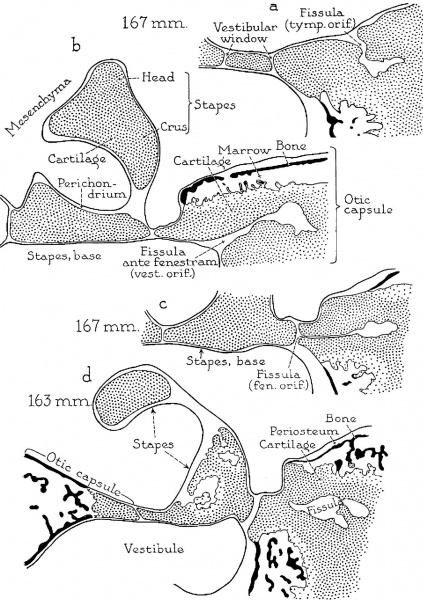File:Anson1948 fig03.jpg

Original file (1,280 × 1,815 pixels, file size: 358 KB, MIME type: image/jpeg)
Fig. 3. Drawings of the stapes and the adjacent fissular region of the otic capsule
Drawings (semi-diagrammatic) from Edinger tracings of the stapes and the adjacent fissular region of the otic capsule, showing developmental changes in the ossicle and in the fissular part of the capsule; X 6.6. Further developmental steps are recorded in the succeeding five plates of figures. In this, and in the five following plates, regular stippling represents unaltered cartilage; less dense stippling stands for rarefied cartilage; the areas treated in black represent bone.
Parts a to c are from a 167 mm. (20 weeks) fetus (Wisconsin series 105) ; (a) slide 23, section 8; (b) slide 21, section 9; (C) slide 19, section 9). Part d is from a 163 mm. (19 week) fetus (Wisconsin series 33; slide 17, section 8). Here, a is taken at the tympanic (cranial. or superior) orifice of the fissula ante fenestram; b, at the fenestral (intermediate) orifice; c, at the vestibular (caudal, or inferior) orifice and throifigh the anterior crus of the stapes, and d, through the body, or midportion, of the fissula.
Abbreviations in this and in succeeding plates are interpreted as follows: Ant. or Ant. crus, anterior crus; Cartil, cartilage; fen. orif., fenestral orifice (of fissula ante fenestram); Post. or Post. crus, posterior crus; Tymp. cav., or Tymp. cavity, tympanic cavity (middle ear); tymp. orif., tympanic orifice (of fissula); V est, vestibule; vest. orifi, vestibular orifice (of fissula); V. w., vestibular (oval) window.
The stapes of the 167 mm fetus is still wholly cartilaginous; in the capsule, on the contrary, bone is replacing carti1age( seen on the vestibular surface in a, on the tympanic aspect in c and on both surfaces in b). In the course of this process the cartilage of the fissula becomes separated.
In the 163 mm fetus ossification of the capsule has progressed further; the base and crus of the stapes have been excavated, but bone has not yet appeared.
Reference
Anson BJ. and Cauldwell EW. Stapes, fissula ante fenestram and associated structures in man: V . From the fetus of 160 mm to term. (1948) 48(3): 263-300.
Cite this page: Hill, M.A. (2024, April 27) Embryology Anson1948 fig03.jpg. Retrieved from https://embryology.med.unsw.edu.au/embryology/index.php/File:Anson1948_fig03.jpg
- © Dr Mark Hill 2024, UNSW Embryology ISBN: 978 0 7334 2609 4 - UNSW CRICOS Provider Code No. 00098G
File history
Click on a date/time to view the file as it appeared at that time.
| Date/Time | Thumbnail | Dimensions | User | Comment | |
|---|---|---|---|---|---|
| current | 09:12, 15 October 2017 |  | 1,280 × 1,815 (358 KB) | Z8600021 (talk | contribs) | |
| 09:03, 15 October 2017 |  | 1,481 × 2,279 (546 KB) | Z8600021 (talk | contribs) | ===Reference=== {{Ref-Anson1948}} {{Footer}} Category:Middle EarCategory:Historic EmbryologyCategory:1940's |
You cannot overwrite this file.
File usage
The following 2 pages use this file: